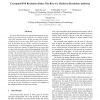Free Online Productivity Tools
i2Speak
i2Symbol
i2OCR
iTex2Img
iWeb2Print
iWeb2Shot
i2Type
iPdf2Split
iPdf2Merge
i2Bopomofo
i2Arabic
i2Style
i2Image
i2PDF
iLatex2Rtf
Sci2ools
NDSS
2008
IEEE
2008
IEEE
Corrupted DNS Resolution Paths: The Rise of a Malicious Resolution Authority
We study and document an important development in how attackers are using Internet resources: the creation of malicious DNS resolution paths. In this growing form of attack, victims are forced to use rogue DNS servers for all resolution. To document the rise of this “second secret authority” on the Internet, we studied instances of aberrant DNS resolution on a university campus. We found dozens of viruses that corrupt resolution paths, and noted that hundreds of URLs discovered per week performed drive-by alterations of host DNS settings. We used the rogue servers discovered in this analysis to document numerous live incidents on the university network. To measure this problem on the larger Internet, we generated DNS requests to most of IPv4, using a unique label query for each request. We found 17 million hosts responding, and further tracked the resolution path they used to reach our NS. Unable to find plausible harmless explanations for such a large number of open recursive ho...
| Added | 01 Jun 2010 |
| Updated | 01 Jun 2010 |
| Type | Conference |
| Year | 2008 |
| Where | NDSS |
| Authors | David Dagon, Niels Provos, Christopher P. Lee, Wenke Lee |
Comments (0)

